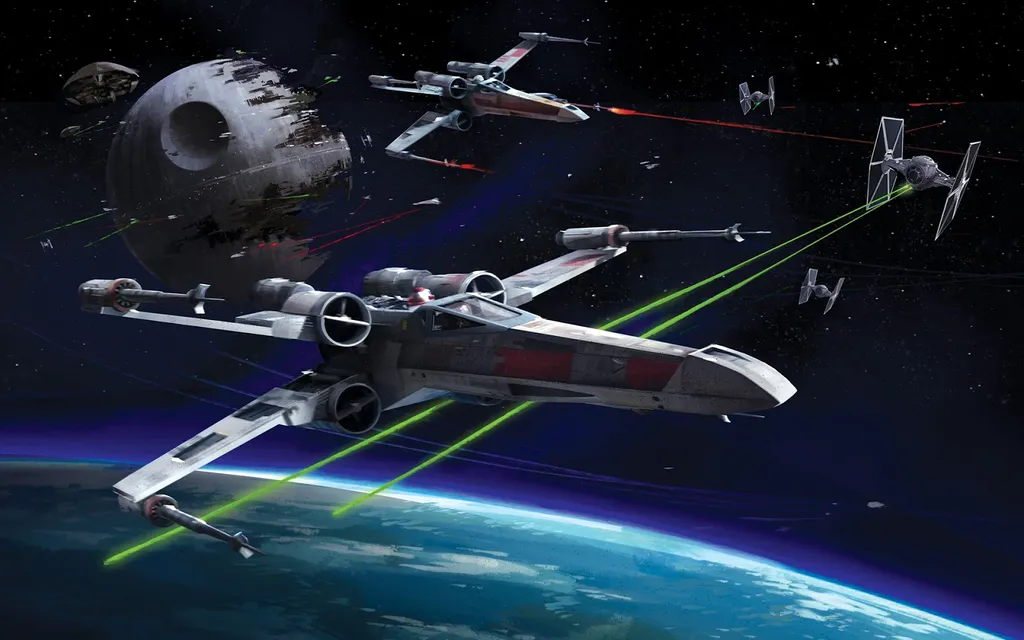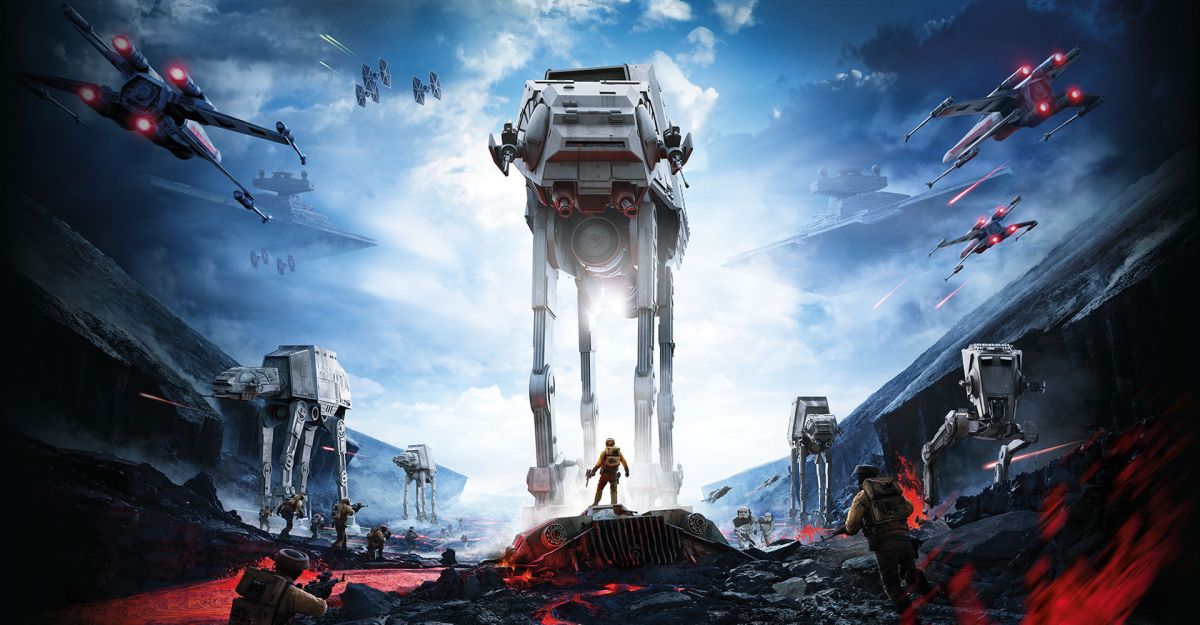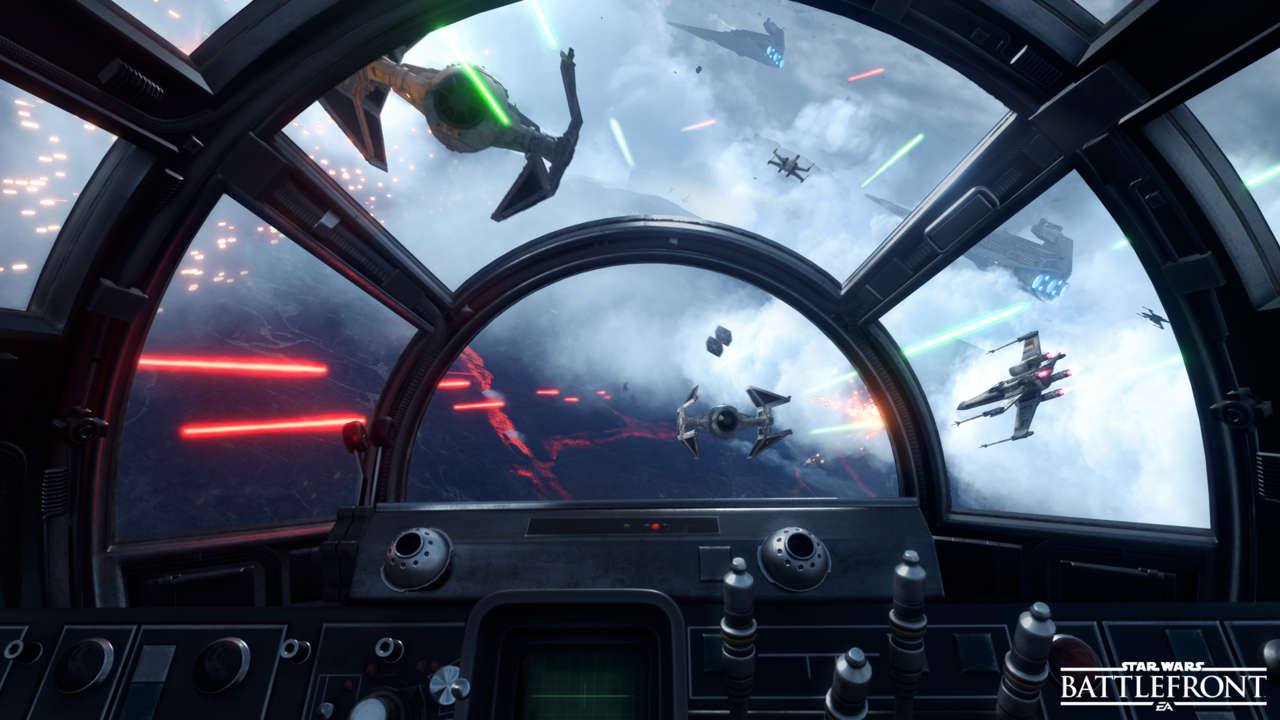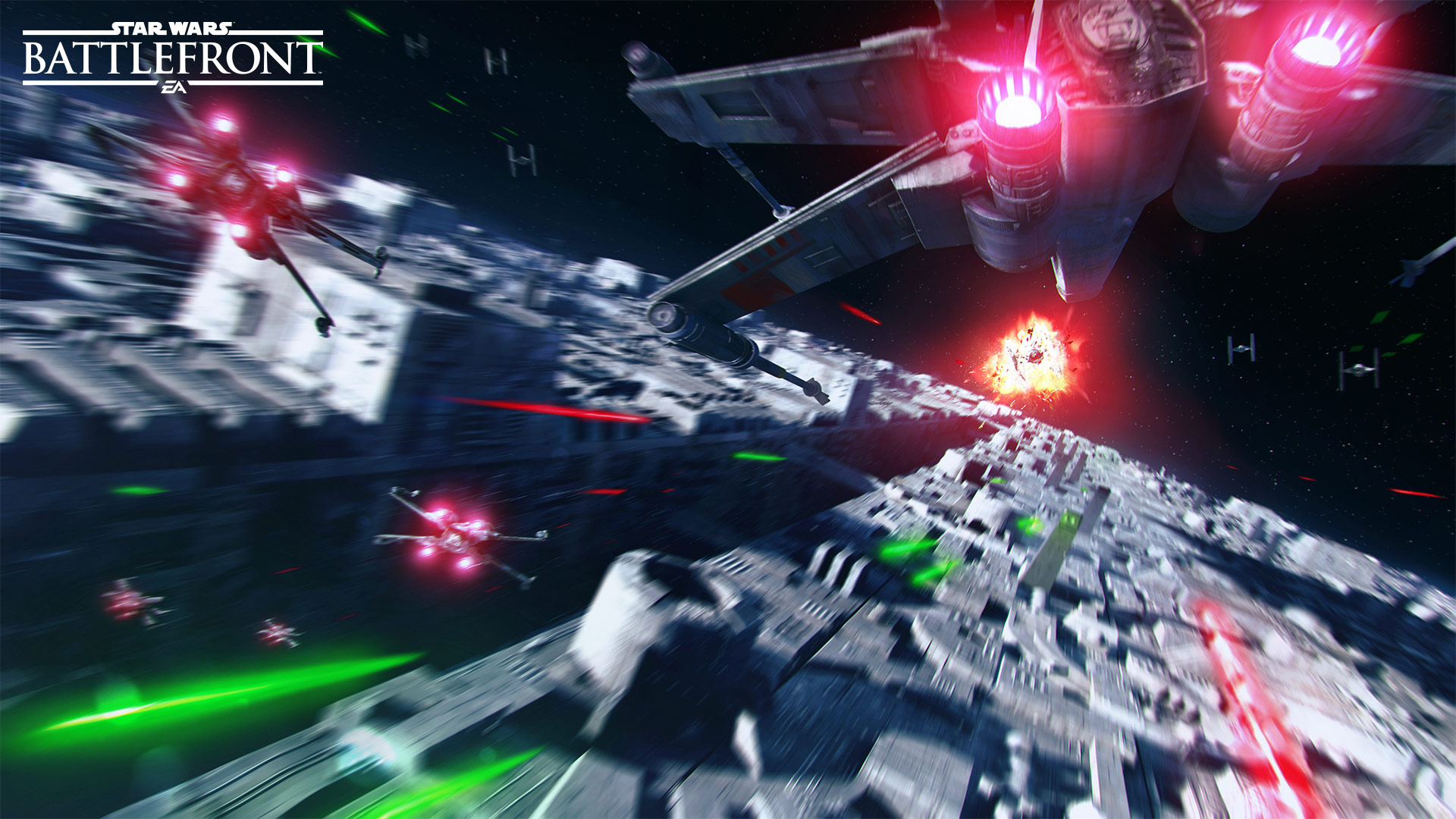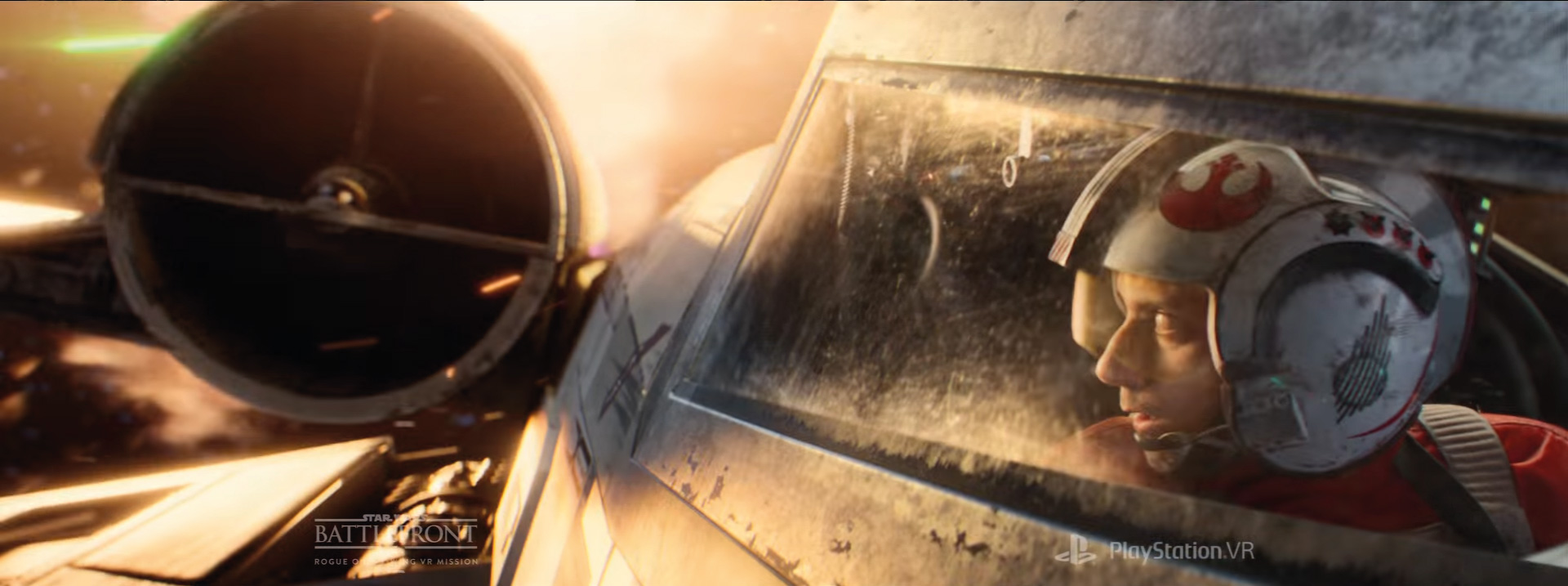I have a difficult time describing Star Wars Battlefront Rogue One: X-Wing VR Mission as anything but embarrassingly indulgent.
The PlayStation VR experience opens to a simple menu screen invaded by the descending foot of a massive AT-AT walker. The moment pushes me to crane my neck upward, using the replica to inform users to the magnitude of the space. I watch it slowly tread behind the ‘Settings’ menu option and stomp off into the distance. I start to realize that I’m watching a menu screen far longer than a normal person should.
I hold a button to begin, and the white space is filled with an X-wing. My own X-wing, I gather, by the friendly R2 unit rolling around underneath, beeping and twirling with familiarity. I’m able to teleport to various vantage points around the garage, a feature meant entirely to engorge me in every architectural accuracy and storied ding of the ship. Again, I become awkwardly self aware. I’ve been ogling virtual metal for an objectively strange amount of time.
Perhaps the X-wing VR mission is best measured by how much shameless time I spent silently staring at it. Its vehicles and dogfights are a captivating blend of authenticity and fantasy.
“That is kind of Star Wars,” Criterion art director Kieran Crimmins tells me as I recount my experience to him. “There’s nothing hard to watch in Star Wars.”
“It is this kind of roller coaster ride of spectacle,” adds Criterion designer, John Stanley.
Criterion flourishes in this enchanting space between realism and enjoyment. Their past titles, including Need for Speed and the Burnout series, turn cars into arcade-like experiences they hope will be easy to pick up but difficult to master.
“Criterion are known for doing spectacular vehicle experiences,” says Stanley, “and you definitely don’t get more spectacular than an X-wing.”
Soon it’s time to hop into the cockpit, my R2 loads into the ship exterior just behind me, per protocol. I’m wearing the standard pilot garb and admiring a detailed arrangement of buttons and gauges, able to carelessly fumble with panel controls for the targeting computer and blaster configuration. A push of a button, and I’m in space. The R2 squeaks incoherently, but my character answers in just a way that both translates and responds, and I smile at the familiarity of the series’ dialogue pattern. The robot seems to be confidently doubting my piloting — the droid sass is also familiar.
I’m staring again, this time without care, for ages out of my cockpit as I glide towards my flight team. There’s no inaccessible angle, so I lift myself to peek over the edge of my fighter for a better view at a nearby galaxy. The distant stars and planets aren’t as visually crisp as the exceptional ship interior, but they surround me in a way that only virtual reality can.
The galaxy seems to care about its resolution as little as I do, because the backdrop never struggles to immerse me given the ships in my vicinity. Rebel allies crowd me with X-wings and runners identical to their canon counterparts. In fact, Criterion collaborated so closely with LucasArts that this VR mission is now an official entry in the Star Wars lore, they’ve told me.
Unsurprisingly, the rebels need a small unit of ships to respond to a distress call in Imperial territory. Nobody seems to mind that I’m ceaselessly circling our fleet during the briefing, busy acclimating myself to the simple control scheme. The left stick controls throttle, the right is used for direction. The DualShock’s triggers are relegated to my shields and attacks. Best of all, I am my own camera control. First-person flight’s usual chaos, I found, melts away when you can easily watch it unfold around you.
We warp into an asteroid field and search for our objective, blasting a path through small debris and smoothly weaving through larger rocks with little maneuvering resistance. My charmingly voice-acted teammates banter and poke fun at the inexperience of my character, who’s designed to parallel the player’s own amateur state.
After convening with the target U-wing, a new ship introduced with the Rogue One film, a flock of enemy TIE fighters appear, howling in the distance, to kick off a dogfight at the perfect time. Criterion paces the X-wing Mission carefully, layering experiences in a way that will welcome fresh VR players. I had learned to observe thanks to the walker at the main menu, mastered controls while admiring the Rebel fleet, and found my firing footing while gleefully zooming between space rocks. Without noticing or trying, I’d become comfortable with Battlefront’s VR mode, Criterion using irresistible pieces of Star Wars to bait me through their subtle tutorial.
The seamless structure is a result of Criterion’s almost absurdly shotgun development style. This is the studio’s first released virtual reality game, yet they’ve made nearly 50 VR titles in-house.
“We’ve got this really amazing hackathon culture in the studio,” Stanley says. These frequent development marathons challenge members to create games within a short period of time, and produce what Crimmins calls a “smorgasbord of experiments.” A similar process led to DEXED from Ninja Theory, earlier this year.
“We love experimenting,” says Crimmins, and you wouldn’t doubt it by the smile on his face. “We put a big emphasis on prototyping and playing our games. We call ourselves game-feel experts, which basically means we don’t believe a feature or anything is worth anything until we’ve played it and see how it feels.” Their own connection with the material is the star of the process.
But back to the dogfighting, because that’s what really matters in an X-wing mission.
Thankfully, I’m happy to report it’s enjoyable. The immersive set and tight controls combine into an iconic battleground of weaving targets. Most memorable of the frenetic shooting is the eventual Star Destroyer, whose ominous appearance stirs the same “we’re screwed” feeling that’s core to the Rebel experience this is looking to recreate.
Helpful indicators point out enemies and objectives in the dauntingly dimensional world of space, and though I spent most of my time chasing after them upside down, I didn’t feel VR sickness creeping on me. Less experienced VR users will definitely want to take it easy on the rolling, but the game’s sitting position and stable cockpit elements manage most of the movement — similar to Call of Duty’s Jackal VR experience, or EVE: Valkyrie.
My biggest gripe is that I wish there were more. The mission feels relatively short, ending after the final moments of this battle, but this fact is remedied slightly by the arcade nature Criterion admires. The end screen hoists into view a scoreboard, your stats, and a list of bonus achievements for the enthusiast pilot. It all challenges you to jump back in and enjoy the experience a number of times.
The brevity is remedied yet again by the fact that once it releases on Dec. 6, Rogue One X-Wing VR will be free for all PS VR users who own Star Wars: Battlefront on PlayStation 4. Criterion assures me it will stay PS VR exclusive and coupled with the full game.
After I relinquish my headset, I question Stanley and Crimmins on their experience with VR development; the response is vividly optimistic, and no doubt Criterion’s belief in virtual reality lends itself to the impactful design of their project.
“There’s a certain rule book of kind of visuals we’ve developed over the years for flat screens,” Crimmins says of developers. “Half of it doesn’t work in VR, so it’s really frustrating for a lot of people, especially experts that are working in the field, and half of their expertise now becomes irrelevant.”
He likens the discord to the uninspiring first wave of mobile games, and emphasizes that creators need to develop a new language that understands what works best with the technology.
“But at Criterion, that’s kind of perfect,” Crimmins continues. Their atypical approach to development is equipped for “rewriting the language of VR.” They pull successful features from their many trial creations, and even find inspiration in the avant garde world of experimental theater. “They’ve [theater groups] been doing that kind of fully immersed experience and directing people’s attention – stuff like that – for a long time,” Crimmins explains. “A lot of the stuff they do is really, really relevant in VR.”
https://www.youtube.com/watch?v=-R1kOWgBxW4
It’s the futility of the standard cinematic language that brings a chuckle from these two. The old paradigm spent years learning to manipulate 2D images and perfect techniques for utilizing screen space and corners.
Crimmins ends his pondering: “You can’t have any of that. You’ve got to rewrite it.”
Star Wars Battlefront Rogue One: X-Wing VR Mission is certainly a confident entry in VR’s sprouting lexicon. A headset and the push of a button launches you into the well-crafted dream of virtually every Star Wars enthusiast. It’s a bit brief considering how good it is, but when the experience is as carefully planned and fine tuned as this, the dream is as simple as noticeably tarnished metal, a familiar orange jumpsuit, a series of metallic squeaks ringing from over my shoulder, and a flurry of deadly lasers shooting over the other.
Sharon is a freelance games journalist and Editor-in-Chief of Twinfinite. You can follow her on Twitter: @Sharoogala.

